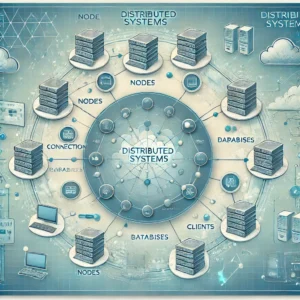Here you can download the free lecture Notes of Distributed Systems Notes pdf – DS notes pdf materials with multiple file links to download. The Distributed Systems Notes (Distributed Systems lecture notes) starts with the topics covering the different forms of computing, Distributed Computing Paradigms and Abstraction, The Socket API-The Datagram Socket API, Message passing versus Distributed Objects, Distributed Objects Paradigm (RMI), Grid Computing Introduction, Open Grid Service Architecture, etc.

Distributed Systems Notes pdf – DS notes pdf file
Latest Distributed Systems lecture Notes Material Links
Complete Notes
Link – Complete Notes
Unit 1
Link – Unit 1 Notes
Unit 2
Link – Unit 2 Notes
Unit 3
Link – Unit 3 Notes
Unit 4
Link – Unit 4 Notes
Unit 5
Link – Unit 5 Notes
Old Material Links
Link: Complete Notes
Note :- These notes are according to the R09 Syllabus book of JNTU. In R13 and R15, 8-units of R09 syllabus are combined into 5-units in R13 and R15 syllabus. If you have any doubts please refer to the JNTU Syllabus Book.
Introduction to Distributed Systems Notes
Distributed systems form the backbone of many modern technologies. From cloud computing services to mobile applications, they enable seamless data sharing, computation, and communication across multiple machines. Understanding distributed systems is crucial for anyone interested in the fields of computer science and information technology. This article will guide you through the comprehensive study material available for distributed systems, focusing on the lecture notes from Jawaharlal Nehru Technological University (JNTU). These notes cover a wide array of topics, from basic concepts to advanced paradigms, and are available for free download in PDF format.

Distributed Systems Notes PDF
The distributed systems notes PDF is an extensive resource designed to provide students and professionals with a thorough understanding of the subject. The notes cover various aspects of distributed computing, including different paradigms, protocols, and architectures. These notes are particularly beneficial for those preparing for exams or looking to enhance their knowledge in distributed computing.
JNTU Distributed Systems Lecture Notes
Jawaharlal Nehru Technological University (JNTU) offers a detailed syllabus for distributed systems that aligns with industry standards. The lecture notes from JNTU are highly regarded for their depth and clarity, providing students with a solid foundation in distributed systems. Compared to notes from other universities, JNTU’s materials are comprehensive and well-structured, making them an excellent choice for students aiming to master distributed computing concepts.
Detailed Description of Topics Covered
Distributed systems encompass a broad range of topics, each critical to understanding how these systems operate and interact. Here is a detailed breakdown of the key topics covered in the notes:
- Monolithic and Distributed Computing: This section introduces the evolution of computing architectures, from monolithic systems to distributed networks. It explains the benefits and challenges of distributed systems, highlighting how they differ from traditional computing models.
- Parallel and Cooperative Computing: This topic explores how distributed systems can perform multiple tasks simultaneously, improving efficiency and performance. It covers parallel processing techniques and cooperative computing models that enable distributed systems to work together seamlessly.
- Network Basics and Distributed Applications: A fundamental understanding of networking is essential for building and managing distributed applications. This section delves into network protocols, architectures, and the principles of designing distributed applications that can communicate effectively across various networks.
Links to Download Distributed Systems Notes PDF
Here are the links to download the comprehensive notes for each unit of the distributed systems course:
- Complete Notes: Download Complete Notes
- Unit 1: Introduction and Basic Concepts: Download Unit 1 Notes
- Unit 2: Distributed Computing Paradigms: Download Unit 2 Notes
- Unit 3: Socket API and Client-Server Paradigms: Download Unit 3 Notes
- Unit 4: Distributed Objects Paradigm: Download Unit 4 Notes
- Unit 5: Grid Computing and OGSA: Download Unit 5 Notes
Topics Covered in Distributed Systems Notes PDF

Each unit of the distributed systems notes PDF covers specific topics, ensuring a comprehensive understanding of distributed computing principles. Here is a summary of the topics covered in each unit:
- Unit 1: Introduction and Basic Concepts
- Definitions and examples of distributed systems
- The strengths and weaknesses of distributed computing
- Operating system concepts relevant to distributed computing
- Network basics and the architecture of distributed applications
- Inter process communications, event synchronization, and threading
- Data representation, encoding, and protocols
- Unit 2: Distributed Computing Paradigms
- Overview of different distributed computing paradigms
- Message passing paradigm and the client-server model
- Peer-to-peer paradigm and message-oriented middleware (MOM)
- Remote Procedure Call (RPC) model and distributed objects paradigms
- The mobile agent paradigm and network services paradigm
- Unit 3: Socket API and Client-Server Paradigms
- The Datagram Socket API and Stream-Mode Socket API
- Connection-oriented and connectionless server models
- Iterative and concurrent servers
- Group communication, unicast, and multicast models
- Reliable and unreliable multicasting
- Unit 4: Distributed Objects Paradigm
- Message passing versus distributed objects
- Distributed object systems, including RMI and CORBA
- Java RMI architecture and API
- Comparison of RMI and socket API
- Unit 5: Grid Computing and OGSA
- Introduction to grid computing and the grid problem
- Virtual organizations and grid architecture
- Merging grid services architecture with web services
- Open Grid Service Architecture (OGSA) and its components
- The Globus Toolkit and its implementation
Always Choose Smartzworld for Downloading Notes
Smartzworld is a trusted platform for downloading high-quality educational notes. It provides reliable and up-to-date resources that cater to the diverse needs of students. Whether you are preparing for exams or simply looking to expand your knowledge, Smartzworld offers a vast collection of study materials that can help you succeed.
DOWNLOAD NOW
Benefits of Free Distributed Systems Handwritten Notes PDF
Handwritten notes offer several advantages over printed or digital materials. They provide a personal touch, simplifying complex concepts and enhancing retention. Handwritten notes are often crafted by experts and contain valuable insights that can help students grasp challenging topics more easily.
Distributed Systems Notes and Study Material PDF Free Download
The distributed systems notes and study materials are available for free download, providing an accessible resource for students and professionals alike. These materials are designed to complement the primary notes, offering additional perspectives and insights into distributed computing.
Additional Resources and Books for Distributed Systems
For those seeking to further their knowledge in distributed systems, several textbooks and online resources are recommended:
- “Distributed Systems: Principles and Paradigms” by Andrew S. Tanenbaum and Maarten Van Steen
- “Grid Computing” by Joshy Joseph & Craig Fellenstein
- “Java Network Programming” by Elliotte Rusty Harold
- Online courses and lectures available on platforms like Coursera, edX, and Khan Academy
Distributed Systems Notes PDF from JNTU
The distributed systems notes from JNTU are tailored to meet the demands of the curriculum, providing students with a robust understanding of distributed systems. These notes are praised for their clarity and depth, making them an invaluable resource for anyone studying distributed computing.
FAQs About Distributed Systems Notes PDF
Here are some common questions and answers regarding the distributed systems notes PDF:
- Where can I download the Distributed Systems Notes PDF?
- You can download the notes from the provided links for each unit or the complete set from Smartzworld.
- How to download the DS Notes PDF?
- Simply click on the links provided in this article to access and download the notes.
- How many modules are covered in DS Notes PDF?
- The notes cover five comprehensive modules, each detailing specific aspects of distributed systems.
- Topics Covered in DS Notes PDF?
- Topics range from introductory concepts to advanced computing paradigms, including grid computing and distributed objects.
- Where can I get the complete DS Handwritten Notes PDF Free Download?
- The complete set of handwritten notes is available for free download from Smartzworld, providing an accessible resource for all students.
Conclusion: Maximizing Your Learning in Distributed Systems
Distributed systems are integral to modern technology, and mastering them opens up numerous career opportunities. By utilizing these comprehensive notes and resources, students can gain a deep understanding of distributed systems, preparing them for success in the ever-evolving field of computer science. With a solid grasp of distributed computing principles, students can develop innovative solutions and applications that drive technological advancements.
Reference:
1. A Networking Appnoach to Grid Computing. D.MinoIi, Wiley & sons.
2. Grid Computing: A Practical Guide to Technology and Applications. A.Abbas, Firewall Media.
3. Java Network Programming, E.R.Harold, 2nd edition, 0‘Reilly, SPD.
4. Distributed Systems, Concepts and Design, 3rd edition, GCOul0Ufi8. J.Dol1 imore and Tim Kindbirg, Pearson Education.
5. Ilava Programming with CORBA, 3rd edition, Brose, Vogel, Duddy, Wiley Dleamteeh.
6. ‘ “Client[Server Programming with lava and CORBA. mond edition. Z ROrfali 8z’Dan Harkey, John Wiley sons. ‘ i ‘ K
7. ‘ Grid Compnting – Making the global infrastructure a reality, -Fran V ‘Herman, Ge0ffi’eyC Fox,AnthonyJGHey,Wiley mu, 2010 t. . t
Text books:
l. Distributed Computing, Principles and Applications, M.L.Liu. Pearson Education.
2. Grid Computing. Joshy Joseph & Craig Fellenstein, Pearson education. 2004
Follow us on Facebook and Support us with your Like


